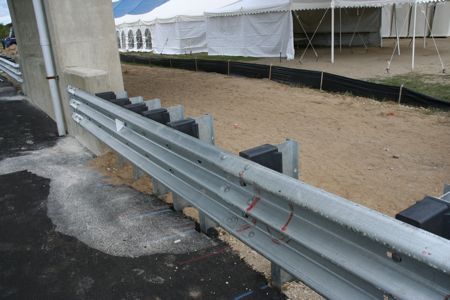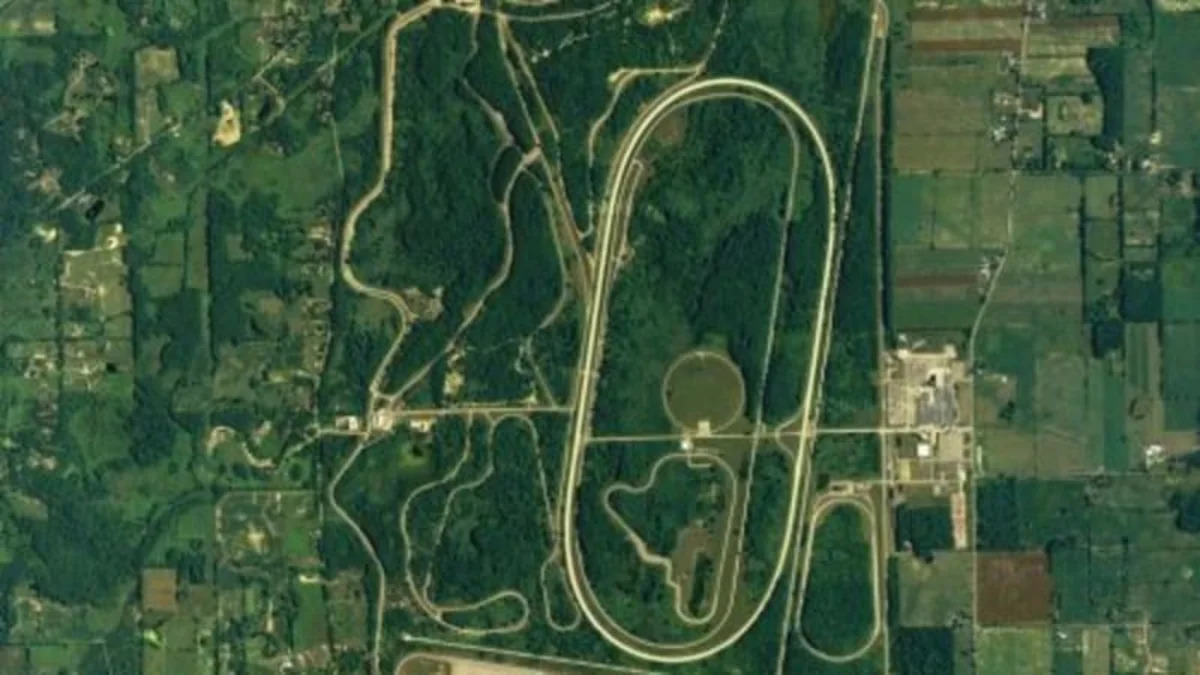The Chrysler proving ground from space
After a six month rebuild program the high-speed oval track at Chrysler's Chelsea Michigan Proving Ground has re-opened. The first official test run on the new track was the 2007 Michigan State Police vehicle evaluation. The 4.71 mile oval was originally constructed in 1953 and had never been completely resurfaced until now. The increasingly bumpy surface has turns banked at an angle that allows for driving at 140 mph without steering input.
The old surface was made of concrete and repairs required significant amount of downtime for the track so that sections could be cut out, refilled and allowed to set. Rather than just resurface the facility, Chrysler completely ripped out all the concrete and rebuilt the base. The old concrete was ground up and used to build the base of the new track. Full drainage was provided around the underside of the entire surface of the track which allowed the ditches that used to line the inside of the road surface to be eliminated.
Continue reading about changes to the oval after the jump.

The new rubber-backed guard rails
The replacement of the ditches with a level shoulder improves safety for test vehicles in case of a loss of control. Another safety addition was guard rails lining the outer edge of the track. The rails are mounted on rubber blocks tied to the mounting posts. This allows out-of-control test cars to the pushed back onto the track instead of flying off into the surrounding woods. Previously, only the turns had guard rails. The new track surface is now comprised of four two-inch-thick layers of asphalt on top of the base made from the old concrete.
The full drainage system should help prevent frost heaves in the new surface. When the surface needs to be redressed every five to six years, now it can be done over a weekend instead of closing the track for weeks or months at time. The surface itself has the same coefficient of friction as the old concrete surface, but the smoother surface should make testing safer and more consistent than before.
After a six month rebuild program the high-speed oval track at Chrysler's Chelsea Michigan Proving Ground has re-opened. The first official test run on the new track was the 2007 Michigan State Police vehicle evaluation. The 4.71 mile oval was originally constructed in 1953 and had never been completely resurfaced until now. The increasingly bumpy surface has turns banked at an angle that allows for driving at 140 mph without steering input.
The old surface was made of concrete and repairs required significant amount of downtime for the track so that sections could be cut out, refilled and allowed to set. Rather than just resurface the facility, Chrysler completely ripped out all the concrete and rebuilt the base. The old concrete was ground up and used to build the base of the new track. Full drainage was provided around the underside of the entire surface of the track which allowed the ditches that used to line the inside of the road surface to be eliminated.
Continue reading about changes to the oval after the jump.

The new rubber-backed guard rails
The replacement of the ditches with a level shoulder improves safety for test vehicles in case of a loss of control. Another safety addition was guard rails lining the outer edge of the track. The rails are mounted on rubber blocks tied to the mounting posts. This allows out-of-control test cars to the pushed back onto the track instead of flying off into the surrounding woods. Previously, only the turns had guard rails. The new track surface is now comprised of four two-inch-thick layers of asphalt on top of the base made from the old concrete.
The full drainage system should help prevent frost heaves in the new surface. When the surface needs to be redressed every five to six years, now it can be done over a weekend instead of closing the track for weeks or months at time. The surface itself has the same coefficient of friction as the old concrete surface, but the smoother surface should make testing safer and more consistent than before.


Sign in to post
Please sign in to leave a comment.
Continue